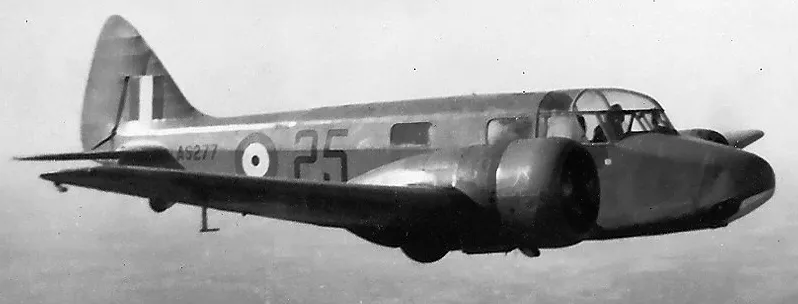Airspeed Oxford

Airspeed A.S. 10 Oxford Mk. II, RCAF (Serial No. AS277), 25, in flight over Saskatchewan, 1942.
The Airspeed AS.10 Oxford was a twin-engine monoplane aircraft developed and manufactured by Airspeed. It saw widespread use for training British Commonwealth aircrews in navigation, radio-operating, bombing and gunnery roles throughout the Second World War.
The Oxford was developed by Airspeed during the 1930s in response to a requirement for a capable trainer aircraft that conformed with Specification T.23/36, which had been issued by the British Air Ministry. Its basic design is derived from the company's earlier AS.6 Envoy, a commercial passenger aircraft. Performing its maiden flight on 19 June 1937, it was quickly put into production as part of a rapid expansion of the Royal Air Force (RAF) in anticipation of a large-scale conflict.
As a consequence of the outbreak of war, many thousands of Oxfords were ordered by Britain and its allies, including Australia, Canada, France, New Zealand, Poland, and the United States. Following the end of the conflict, the Oxford continued to achieve export sales for some time, equipping the newly formed air forces of Egypt, India, Israel, and Yugoslavia. It was considered to be a capable trainer aircraft throughout the conflict, as well as being used a general-purpose type. A large number of Oxfords have been preserved on static display. Wikipedia
CASPIR Aircraft Groups:
RCAF On Strength (821), Canadian Aircraft Losses (168)Oxford Mk. I AS552
Taken on strength at No. 2 Elementary Flying Training School at Fort William, Ontario. Category C14 damage at Hamlick relief field at 12:00 on 18 September 1941, reported by No. 35 Service Flying Training School at North Battleford, Saskatchewan. To No. 4 Training Command with this School on 10 November 1941. To Aircraft Repair for crash repairs on 11 April 1942, with 42:30 logged time. Back to No. 4 Training Command on 19 September 1942. Destroyed in a crash at 12:15 on 8 July 1943. Instructors Sgt. F.J.B. Rawlings, killed in crash; and Sgt. N.I. Meller (or Mellor?), died shortly after being admitted to North Battleford hospital, both RAF. Came down in farm field, 100 yard short of Breda relief field. Witnesses report an engine explosion in flight, aircraft right engine and right wing were on fire when it crashed. Several civilians were at crash site within minutes and extracted crew before fire completely destroyed aircraft. Request to scrap from No. 35 SFTS dated 25 July 1943. Scraped at No. 35 SFTS.
1941-08-07 Taken on Strength No. 2 Training Command 2019-08-20
1941-September-18 Accident: 35 Service Flying Training School Loc: Relief Landing Ground Names: Stanton
1943-July-08 Accident: 35 Service Flying Training School Loc: R2 Brada Names: Mellor | Rawlings
1943-08-23 Struck off Strength Struck off, reduced to spares and produce 2019-08-20





 Commonwealth War Graves Commission
Commonwealth War Graves Commission Find-A-Grave.com
Find-A-Grave.com Library and Archives Canada Service Files (may not exist)
Library and Archives Canada Service Files (may not exist) North Battleford City Cemetery, Canada
North Battleford City Cemetery, Canada Oxford Trainer
Oxford Trainer Wikipedia Oxford Trainer
Wikipedia Oxford Trainer Harold A Skaarup Web Page
Harold A Skaarup Web Page
 RCAF.Info - RCAF Station North Battleford SK
RCAF.Info - RCAF Station North Battleford SK Saskatchewan Virtual War Memorial - Base History
Saskatchewan Virtual War Memorial - Base History